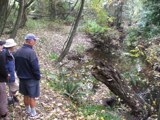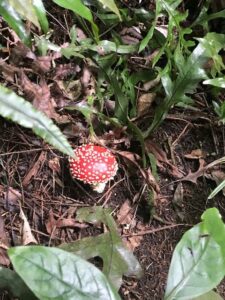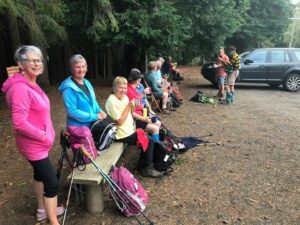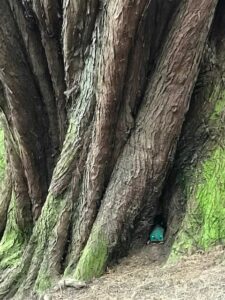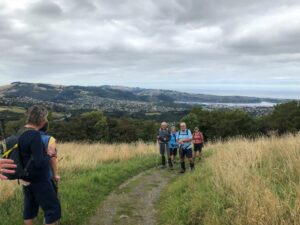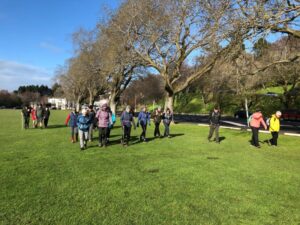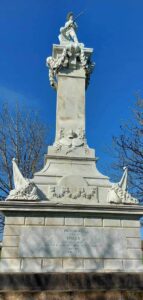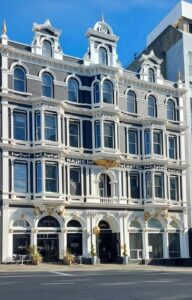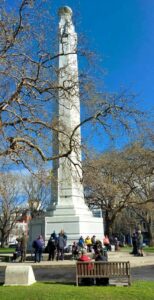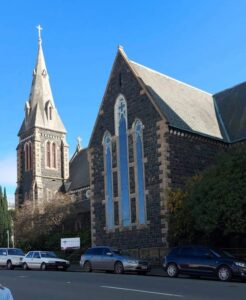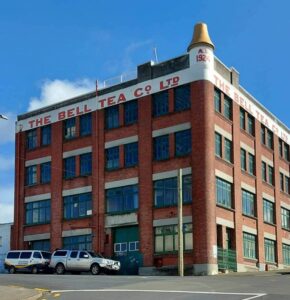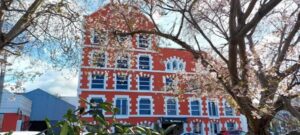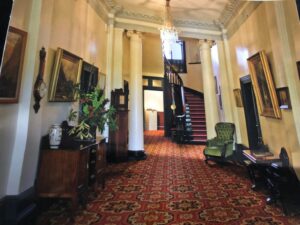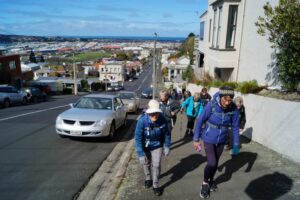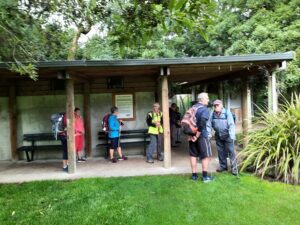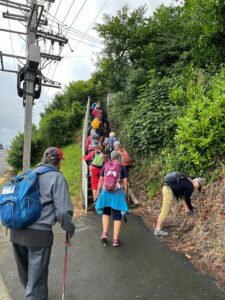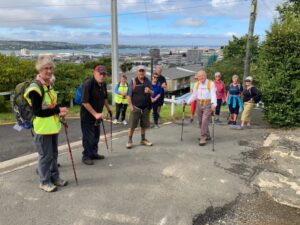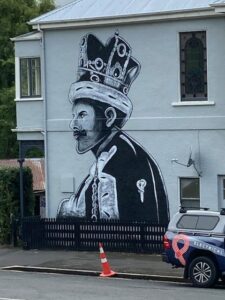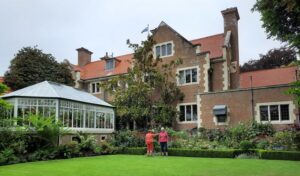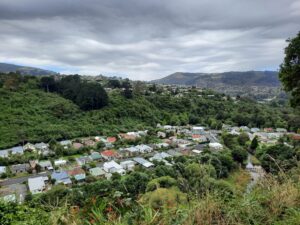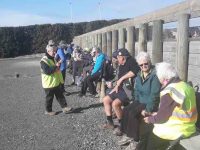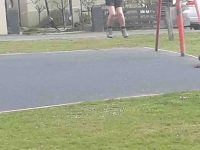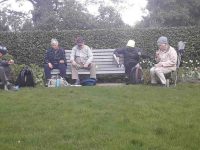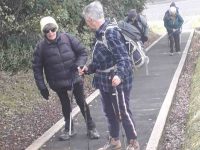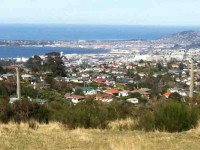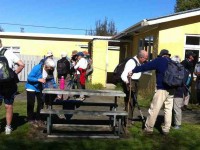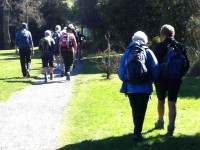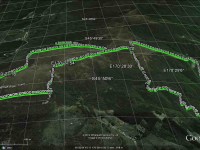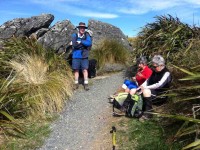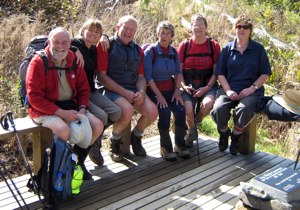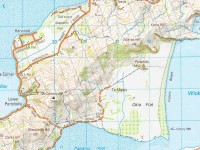Apr 10 2010
Apr 16 2008
Traquair/Whare Creek Track & Woodside Glen.
16/4/2008. Traquair/Whare Creek Track & Woodside Glen.
With inclement weather threatening the joy of a beach walk (Purakanui and Canoe beaches) and only 2 hikers along with 2 leaders, a decision was made to seek dry bush cover instead, and so we headed for the recently-upgraded Outram Glen walk. Neil diverted us however to a nearby track he had lately helped to clear
Dec 09 1980
Flagstaff Creek Walking Track
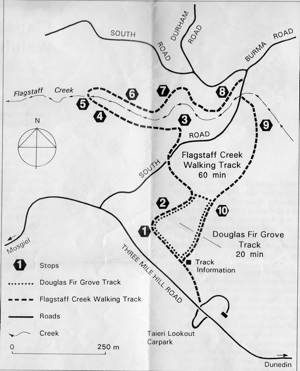 Planting commenced at Flagstaff Forest in 1906, with introduced trees of a wide variety and type. By 1914 22 different species had been tried, many of them deciduous trees from Britain. These species were unable to compete with weed growth and a switch to evergreen pines was undertaken. Planting from then on was concentrated on the use of Radiata pine, Ponderosa pine, Douglas fir and Larch with a scattering of Spruce in the wetter gullies.
Planting commenced at Flagstaff Forest in 1906, with introduced trees of a wide variety and type. By 1914 22 different species had been tried, many of them deciduous trees from Britain. These species were unable to compete with weed growth and a switch to evergreen pines was undertaken. Planting from then on was concentrated on the use of Radiata pine, Ponderosa pine, Douglas fir and Larch with a scattering of Spruce in the wetter gullies.
Following WWI there were a number of returned servicemen in need of rehabilitation work and these in the main provided the labour force. During the depression in the 1930s the city made considerable progress in forestry with an ample labour force.
Clearfelling of the first crop commenced at Flagstaff in 1934. Local log sales required approximately 10 hectares per annum to be clear-felled. Two export log trials were undertaken, one in 1959 and the other in 1962.
Export logging on a regular basis commenced in 1969 and continued at a volume of approximately 100,000 cubic metres annually. This reduced to approximately 14,000 cubic metres as a result of the lack of planting between 1940 and 1969. Export logs were sold to Korean, Japanese and Chinese buyers.
With the income and confidence generated by earlier sales the council in 1970 decided to expand its forest estate. Following that decision it added several thousand more hectares making a gross forested estate of 10,000 hectares.
We have a current planting programme of 350 hectares per annum. The replantings and new plantings are in Radiata pine with small annual plantings of Douglas fir and Macrocarpa. All stands have been established with the best quality seed stock available and have been pruned and thinned to produce high quality sawlogs and peelers to maximise the value and the market opportunities of timber produced.
From City Forests Ltd hard copy information sheet
May 03 2024
Upcoming Trips
Link to Trip Organisation Guidelines for leaders and trip participants.
Link to Track Grading information.
Link to Copy of Trip Programme for printing.
Gradings are provisional and may change following recce. Distances are for road travel from Mosgiel car park. Costs may change with fuel price fluctuations and distance changes. This page has all current updates.
Last updated 7/04/2024.
Wednesday 8 May.
Trampers. Goldfields, Lawrence. Grade 4. $21. 81 km (distance PJP to Lawrence). Leaders: Anne Ward, Di Bezett, Lyn Keene.
Hikers. Macandrew Bay, Greenacres. Grade 2. $7. 24 km. Leaders: Jill Dodd, Katrina McKenzie.
Wednesday 15 May.
Trampers. Mountain Road, South Waikouaiti River. Grade 4. $8. 28 km. Leaders: Graham Thurlow, John Gardiner.
Hikers. Ross Creek. Grade 2.5. $5. 17 km (distance PJP to Rockside Road). Leaders: Pam Clough, Jay Devlin.
Dec 02 2023
Follow the Leith

2. 29/11/2023. Hikers Waters of the Leith. Grade 2. Leaders: Jan/ Pam
Having led this trip several times over the last 10 years or so, without much variation to it, this report will be reasonably brief.
Mar 22 2023
Booth Road, McGouns, Pineapple Track, Ben Rudd
No. 43 on old hardcopy list of 113 club tramps. “Booth Rd – Ben Rudd, R Hakkaart. Year Round”
4. 15/03/2023. Hikers. McGouns/ Wakari Bike Track Grade: 2.5 Leaders: Jay and Jenny
17 keen hikers gathered at the bottom of the Pineapple track in Tanner Road. We entered the Cragieburn track at the Corner of Wakari Road and Tanner Road. We walked up a short distance to an historical site where there were remnants of dairy farming in 1860. This area is well preserved and a lovely new seat has been installed for people to sit and enjoy the views over Dunedin and its surrounds.
We then proceeded on to the Wakari Bike track which took us through attractive bush and meandering Ross creek.
The track was good underfoot and pleasant walking. We reached the top of the track in 45 minutes where we had our morning tea.
After that we carried on the track which was a mixture of lots of ups and downs.
The trees here were a mixture of natives and exotics. The redwoods were huge and stunning.
We carried on then to join the McGouns Track which has beautiful unspoilt bush. This was steep in places but nothing like getting the heart rate up to feel alive. At the end of the McGouns Track we were supposed to turn right but the leader took us left up another steep climb where we had our well deserved lunch break and there we enjoyed views of the city and harbour.
After lunch it was all downhill for a change to the cars. We had two prospective hikers with us today, Margaret and Kay. Coffee was at Sunnyvale.
Sep 15 2022
Street Walk: Town Belt areas.
10. 14/09/2022. Hikers. Street walks of Dunedin – from the Oval. Leaders Jenni and Bruce
Memorials, buildings and landmarks that we drive past regularly were revisited when 24 hikers ventured out on a clear but cold Wednesday. Wearing many layers of clothing, we set off from the Oval, which as one clever quiz team recalled, covers 22.9 acres.
Henry Ely Shacklock, Prince of Wales Hotel, Carnarvon Station, Bell Pepper Blues, the Empire Hotel – the home of the Dunedin Sound, all conjured up memories of time passed.
Further along Princes Street, we admired the beautiful refurbishment of Wains Hotel, now a 5 star boutique hotel and its across the road neighbour, Distinction Hotel, formerly the 1937 Chief Post Office. This building housed a huge number of public servants over the years.
Morning tea was taken in the sunshine on the Dunedin Cenotaph.
There was much to observe and discuss in the Exchange. The Cargill Monument, originally erected in the Octagon, but shifted to the Exchange in 1872. A mammoth effort, considering the detail.
It was interesting to visit Queen Elizabeth II’s, great-great-grandmother, Queen Victoria, who reigned for 63 years and seven months. What an amazing length of service from our two stoic royals.
Rattray Street, today a crumbling collection of buildings, has huge memories for many of the team ….. Hong Kong Café, Sunset Strip, Dragon Café, Tai Ping Restaurant, the Rolling Stones party place, Calder Mackay and the Crown Hotel to name a few. Along Manse Street, up Stafford Street. Ross and Glendining Ltd, Kempthorne Prosser, Sew Hoys and the St Mathew’s Anglican Church. The architect for the church was William Mason, MP and Dunedin’s first mayor and yes related to Mason and Wales of today.
Next came the stories from the Rugby Hotel, topless waitresses (from one who knows) and the Bell tea building.
The Market Reserve was our next destination, and there’s miles of history around what was formerly a tidal inlet, the original shore of Otago Harbour. The Victorian style men’s toilets were discussed, ladies were no where to be found. The Crown Roller Mills building has now been beautifully restored and houses 12 luxury apartments and a restaurant.
We admired the house Johnny Jones lived in (39 Melville Street) which is still in great shape and then popped our heads into The Dunedin Club which was built for him. Royalty have stayed there. This is used today as a hub for business people, weddings, conferences etc. It also has eight luxurious suites for accommodation. As an aside did you know that Jones donated the land for the building of St Paul’s Church in the Octagon?
We zigzagged up the 98 steps (one of the quiz questions), to Maitland Street and some viewed the Bottled Sunshine sign for the Lanes lemonade factory. Some missed that! Carroll Street which was previously known as Walker Street, was the red-light district of Dunedin and associated crime. The top block of Carroll Street was known as the Devil’s half acre. The arrival of the Lebanese community helped improve the area, but the reputation was renowned. Now, we’re informed the red-light district is all around us, with online ordering and home deliveries!
The team made good progress up the steep Maitland Street and arrived at our lunch stop at Unity Park. The wind chill factor caused us to depart sooner than we would have liked. We were happy to know the Trampers had reached the top of Mt Cargill for their lunch stop but they couldn’t see us waving!
The only other site worth mentioning was from Walter Street and overlooking where Carisbrook once was and pondering what might be in store for the Forbury Trotting site.
Back through the Southern Cemetery, a rather sad place with many delipidated plots.
At the Oval, we popped into the Kensington for a short quiz on the day’s findings. One of the team’s names was “Time for Ovalteam” – clever! The team though who won the quiz was “Outram Plus 1” and received boxes of Smarties, which seemed appropriate. Drinks and homemade nibbles were enjoyed, service was a bit slow.
Walk was around 9 km.
We would like to thank everyone for their keen participation for an enjoyable day out.
Bruce and Jenni.
Note: Toilets on this walk are few and far between. If you want the Oval toilets open, you need to organise this with the DCC – www.dunedin.govt.nz/do-it-online/book/facility-bookings or phone 477 4000. The ones in the Exchange area where the ACC building is being erected, are no longer available.
9. 16/02/2022. Hikers. Town Belt Circuit. M. Leaders Linda Partridge and Diane Paterson
Thirteen keen hikers met at Woodhaugh Gardens for morning tea before setting off on a circuit of the northern/central part of the town belt.
We began by taking the zigzag path and steps up from Duke Street. When we reached Queen and Warrender streets, after our first ascent, we viewed the university in the distance and saw up close where many of the students lived in their hillside flats. We met some students from Auckland moving into their new abode and friendly banter ensued between the students and the sprightly TRTC hikers. We also marvelled at the parking arrangements in these narrow steep streets.
We continued on to Cosy Dell and took time to view the tennis courts and the array of historic homes, many now flats that are located in a small area.
More steps (and groans) and we made our way along Park Street to Heriot Row, London Street and then around by Moana Pool to our lunch spot at Olveston.
Unfortunately we felt we were a little early for lunch so low and behold another set of steps were located and we climbed up to Wallace Street and then found a pleasant route back down to Olveston for a well-earned lunch.
After lunch and a brief look at the lovely Olveston gardens our route back took us along streets and tracks through the town belt until we regrouped at Stonelaw Terrace. Given we were making good time we did a detour down Cannington Road and Braeview Crescent before descending on the historic Bullock Track to our cars at Woodhaugh Gardens.
It was a great day with lots of interest including history, panoramic views, friendly students, the very special Green Belt and a few laughs along the way. The circuit we took was around 9kms.
Afternoon tea was enjoyed at the café in the Botanic Gardens.
Linda and Diane
8. 11/9/2019. Hikers. Town Belt- walk, bus trip. Leaders: Pam and Jenny.
Sep 10 2014
Street Walk: Patmos Avenue
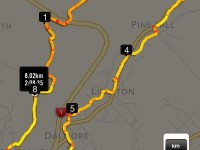
Route. Cars, Patmos Ave, Maxwelton St, Pinehill Rd, Abbeyhill Rd, Cambells Rd, Hillary St, Dover St, Pinehill Rd, Fea St, SH1, George St, Woodhaugh Gardens, part Woodhaugh St, Lower Ross Creek tracks environs, Malvern St, Cars.
23 hikers left cars in Malvern St on a sunny no clouds day. No wind either.
We made our way up Patmos Ave, across the over-bridge of the motor way and on to Maxwelton St.
Does anyone know how this or who this street is named after? Somewhere on this journey we stopped for morning tea.
We passed some very old buildings on the way and there are some historical houses of significance from the
early days. At the end of this wee story there should be some web sites listed than you can pursue if you wish.
At the end of Maxwelton St we moved over to Pine Hill Rd.
We travelled down to 444 Pine Hill Rd and then up an alley onto Campbell Rd and then continued on down hill. Love down hills!
We arrived again at Pine Hill Rd. Lunch was at a small park.
We walked on down to Woodhaugh Gardens. None of us got run over on the way.
Woodhaugh Gardens are a pleasure to walk thru. My parents told me that in 1923/4 they did all of their courting there.
That was what it was called. The bird life was great to listen to. Walking thru the tracks in the gardens we passed the old quarry that closed in 1949 … and the old pub on the corner of Malvern St and Woodhaugh St was only open from 1888 till 1892. This hotel is getting a major makeover, which is good.
The views we had today looking over Dunedin are well worth the climb and the leadership by Bev was awesome even though she didn’t look like a hiker. Too well dressed in her high viz vest and pink nails. Adrienne did a good back up. No one and I mean NO ONE got behind her. Don’t forget to check out the sites. – Elaine.
<a href=”http://en.wikipedia.org/wiki/Pine_Hill,_New_Zealand#The_upper_slopes”>The upper slopes</a>
<a href=”http://en.wikipedia.org/wiki/Pine_Hill,_New_Zealand#Liberton”>Liberton</a>
<a href=”http://en.wikipedia.org/wiki/Pine_Hill,_New_Zealand#Dalmore”>Dalmore</a>
12/5/2010. Street Walk: Hikers. Patmos Avenue. Leaders: Bev, Lesley.
Oct 31 2012
Big (Bivvy) Rock, Pineapple, Davies, Firebreak.
31/10/2012. Trampers. Bullring, Fence-line, Upper Spiers Rd, Flagstaff Walkway, down Pineapple, up Davies, Ben Rudd.
24/9/2008 Bullring, Pineapple, Davies, Firebreak, Big(Bivvy) Rock, Bullring Leaders: Ria L, Hazel
May 09 1989
Racemans Track, Weir, Origins
In 1876 a report was written for the Dunedin City Council outlining the various options available for the supply of water to the low-lying areas in the city. The two options available were the Leith Valley supply which was to be very expensive, or the Silverstream supply which would be cheap and effective but would supply water to only the low levels.
In December 1877, during the on-going debate over the two systems there came a dry spell and Ross Creek Reservoir was so low that a fire in the city drained the reservoir. This incident served to motivate a decision and in December 1877 the Silverstream project was decided on.
By 1880 13 miles of water race was constructed out of a total of 18 miles and in 1881 it consisted of 29 km of winding open earth ditch 3 to 4 feet across, timber sluices, tunnels, weirs and steel pipes. It began at the top weir on Silver Stream and wound around the western slopes of Swampy Summit, Flagstaff and Three Mile Hill to the Southern Reservoir in Kaikorai Valley. It was opened on 15th December, 1881. All eastern tributaries of Silver Stream from the top weir to the Three Mile Hill Road were diverted into the open race by small masonry inlets.
Water shortages still recurred from time to time and it was soon found that the Silverstream scheme was not as wonderful as previously thought. In times of heavy rain the open water-race could not cope with the volume of water while there was not enough storage at the Southern Reservoir for a long period of heavy draw-off.
In 1895 it was decided that additional pumping and storage was required. The final location for a pumping station was at Powder Creek. In 1920 an electric pump was installed at the bottom weir, pumping water up a pipeline and into the water-race when needed. Apart from in 1890, it was not used again until 1928. By 1933 the population growth and the increase in water use made it practical to appoint a full-time attendant at the pumping station.
Since the early 1940s, land subsidence and the need for constant maintenance resulted in much of the open water-race being replaced with pipeline. The water-race in this area of tracks was the only major part that was not piped. Following a severe flood in 1957, the water-race above the pumping station was closed. After this, water for the race was pumped from the pumping station directly up the hill into the open water race.
The Silver Stream Water-Race was abandoned in the late 1960s. The current pumping station moves water along a buried pipeline following a new route to the Southern Reservoir.
In the late 1980s the Track Clearing Group began to re-open and develop the Silver Stream Water-Race Tracks. This group, with the assistance from the WEA over 50s Tramping Club continues to do great work in maintaining these tracks. The late Steve Amies was the founder of both groups and instrumental in re-opening the tracks.
Other matters receiving attention during this time were the afforestation of the water reserves and the detection and prevention of pollution. Considerable planting was done around the Leith and Silverstream catchments. The aim of this policy was commercial as well as functional. It was claimed that afforestation kept down noxious weeds, kept the area free from stock and rabbits, and increased the efficiency of the area as a water catchment as well as increasing the beauty of the country.
Since 1948 the open water race has been progressively replaced with a pipeline. The catchment lies to the West of the Flagstaff-Silverpeak divide, and comprises 4275 hectares which is largely council owned with much of it in native bush, some in tussock and some in exotic plantation.
– Adapted From City Forests Ltd hard copy information sheet and DoC Silver Stream Water-Race Tracks.
Dec 12 1980
Pineapple and Flagstaff Walk
No. 31 on old hardcopy list of 113 club tramps. “Pineapple Track – Swampy Summit. Year Round”
The hills around Dunedin are superb viewpoints to see the city, coastline and ranges of inland Otago. Flagstaff is one such hill and like Mt Cargill to the north allows the walker to pass through several types of vegetation en route to the summit.
Most of the features seen from the walk have strong historic significance. Beyond Signal Hill, the site of Otakou can be seen. When the first European settlers arrived, this Maori settlement was the largest in the region. In 1817 this ‘kaika’ contained 600 very “fine houses, neatly furnished”. From 1833-1841, a whaling station was operating from here. The whalers’ township, known as Musselburgh was nearer the heads. By 1840, 250 Europeans were living around the harbour entrance. It was from Otakou that the earliest immigrants received their first supplies of fresh meat, milk, butter and vegetables. The region south to the Nuggets and inland by the Clutha to as far as the Lammerlaw Range and West Taieri was bought for European settlement of $4,800.
Almost immediately apparent from the walk is the distinctive layout of the centre of the centre of Dunedin. Charles Kettle and a party of surveyors laid out the streets in 1848, using the special features of the Scottish capital, Edinburgh as a guide. The planned settlement took its name in 1845 from the Highlander’s name for Edinburgh. The town belt, the ribbon of bush threading its way through the suburbs, cutting off the inner city from the suburbs also dates from the early surveys. Immigrants were offered land packages on or before their arrival in Otago. Each consisted of a 1/4 acre (1012 sq m) town allotment, a 10 acre 4 hectare) suburban allotment, and a 50 acre (20 hectare) rural allotment, all sold at the rate of £2 an acre ($9.60) a hectare). The town belt separated the town and suburban allotments. Most rural blocks were on the Taieri Plains.
Kettle’s name was given to Flagstaff Hill, but through common usage the term Flagstaff became accepted and superseded Mt Kettle.
As early as 1925 there was skiing on Swampy Hill and Flagstaff. Sixteen years later an exceptionally heavy snowfall convinced many of the return of very cold winters. Many Otago skiers spent several weekends clearing the hillside of stones and boulders but unfortunately for them the snow never came back.
In these early days of settlement the forests all but cut off Dunedin to the north. Long before a road was made around Mt Cargill, the track known as ‘Johnny Jones’ (the Waikouaiti whaler) track linked the Dunedin area with Waitati via Flagstaff and Swampy. In 1859 snow poles were put up along the track to guide travellers caught out in storm or mist.
A road was made between Whare Flat along the inland flank of the hill to near the saddle between Flagstaff and Swampy Hill in 1870. The settlers at Whare Flat used it to draw their supplies of timber from the bush on the other side of Flagstaff. In later years these old roads fell out of use.
The settlers, utilising a number of small sawmills, ‘cut-out’ much of the bush on the eastern flank of Swampy Hill and Flagstaff. The Pineapple Track at the northern end of Flagstaff passes through such ‘cutover’ forest. From here podocarps were milled to provide local building materials. Only an occasional remnant podocarp remains. Mahoe (whitey wood) is plentiful here while on the forest floor and tree trunks, many species of fern abound. The upper part of the track here includes totara saplings and old stunted broadleafs with twisted limbs, growing in a slightly drier soil. Hounds tongue and “hen and chicken” type ferns hang from the dead tree trunks.
The tussock on the part of the walk from the Whare Flat Road car park (known as the ‘Bullring’) is being taken over by native scrub: flax, manuka and the occasional Olearia – although these get knocked back by fires from time to time. Native orchids are common here, especially in early summer. Skylarks can be heard on this hill from sunrise to sunset.
The summit: An unobtrusive plane table helps point out the many interesting places which can be seen from here. To the north you can see the higher hill of Swampy with its buildings from aviation and scientific experiments, and to its east is Mt Cargill, topped by a TV transmitter. Further away is the city and the drowned valley of Otago Harbour with the Peninsula beyond and the sand dune suburbs of St Clair and St Kilda connecting this with the mainland.
Turning northwards, the track crosses the tussock-covered scenic reserve beyond the summit. In spring and summer, orchids and violets can be seen between the snow tussock. Boulders of volcanic rock are scattered over the hill top, some of which are clustered in lines of ‘stone stripes’ down the hillside.
The tussock grassland now largely covering the summit and upper slopes is only 2-300 years old. Before this , forest covered the entire area. Periodic fires have encouraged the tussock grassland. Snow tussock, mountain flax and Astolia are the most common native plants, while manuka is encroaching into the grassland that fire has not recently reached.
Once into the bush, the track drops through regenerating shrub-land from the signpost at the top of the Pineapple Walk. It was near this spot that in the 1920s a well-known grocer and tramper guiding parties to see the views would pause, and pass around a tin of pineapple. It became a tradition that once empty the tin would be left on a tree or fence post – giving the track the name.
From clearings on this track can be seen Ross Creek Reservoir and the city beyond, also the Mt Cargill television transmitter and the northern side of Leith Valley. Many shrubs are invading clearings from the bush edge. Fuchsia and pepperwood are common. Grazing has determined the nature of this vegetation with only the unpalatable species surviving.
The Booth Road water treatment station sits in a clearing of ornamental plants. A small round concrete tank in the pines on the left of the track halfway down from this station is also part of the water supply scheme built before the 1950s. A tap near the edge of the bush gives cool refreshing water to the walker on his or her return.
At the Booth Road end of the walkway, the track passes through the Dunedin City Council exotic plantation. Spruce, ash, radiata pine and Douglas fir were planted over 30 years ago as part of growth experiments with these species in the area.
– From DoC hard copy information sheet.
Dec 11 1980
Dunedin’s Water Supply
The first settlers drew their water from the creeks and springs in the area below the Town Belt, the principal sources being the Maclaggan Street, London Street and Regent Road creeks. In 1860 the Town Board tapped a spring in High Street and erected a public pump at the Manse Street corner. Continue Reading »
May 04 2024
Pyramids, Victory Beach
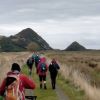 30. 1/05/2024. Combined. Pyramids/Victory Beach. Grade 2.5. Leaders Jenny, Alison, Wendy and Alex
30. 1/05/2024. Combined. Pyramids/Victory Beach. Grade 2.5. Leaders Jenny, Alison, Wendy and Alex
A great turn out for my first time as a co leader with Alison, Wendy, Alex and John. We had a combined group of 30 trampers and hikers. Continue Reading »
May 03 2024
Track Clearing
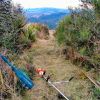 27. 2/05/2024. Track clearing. Leader Phil Keene
27. 2/05/2024. Track clearing. Leader Phil Keene
Autumn is moving along, colours are fading, the tracks were wet and muddy, aided by some impressive pig work but the team were not defeated and completed a full day’s work on McQuilkans. Continue Reading »
Apr 29 2024
Grahams Bush, Old Main Rd, Organ Pipes, Buttars Peak, Mt Cargill, Mt Cutten
 18. 24/04/2024. Hikers. Graham’s Bush/Organ Pipes. Grade 3. 27 km. Leaders: Maria MacNee/Theresa White
18. 24/04/2024. Hikers. Graham’s Bush/Organ Pipes. Grade 3. 27 km. Leaders: Maria MacNee/Theresa White
A twenty-one strong group of hikers met at the rendezvous in Sawyer’s Bay at the Emmanuel Church Car Park. Continue Reading »
